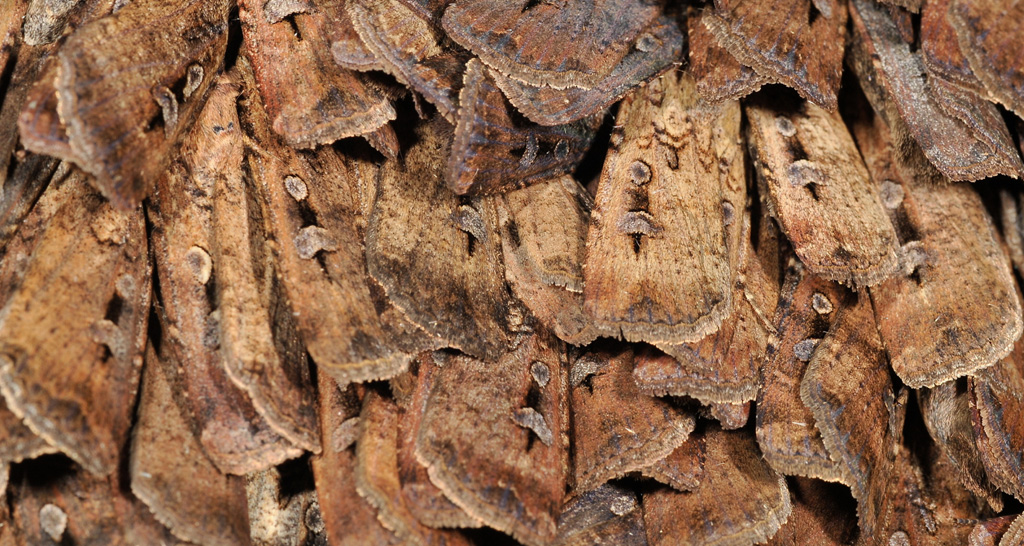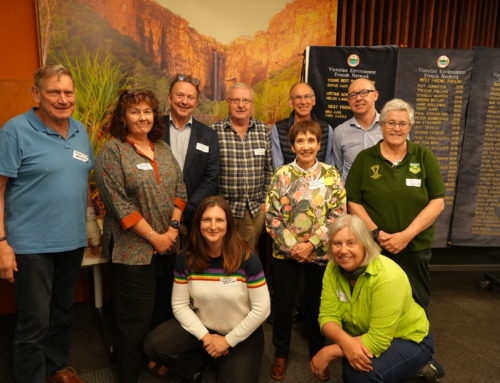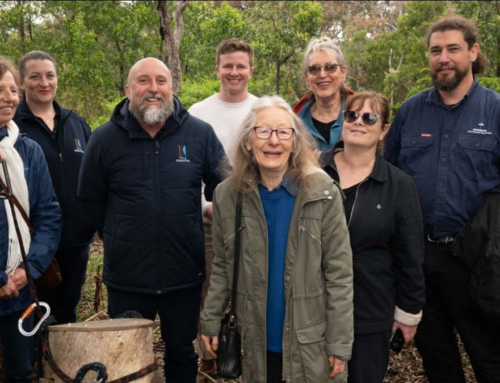
Bogong Moths in a cave at Ramshorn, Victorian Alps. Photo: Jeremy Tscharke | Copyright Parks Victoria
By Marilyn Hewish
I’ve been interested in Victorian moths for about seven years and a question I’m often asked is, “Do moths move around much?” For many species we don’t know but several moths in the family Noctuidae certainly undertake long-distance movements (e.g. Drake et al., 1981). The best-known and most visible example is the Bogong Moth.
Every year Bogong Moths make a remarkable migration through south eastern Australia. In most years they attract little attention, but occasionally vast numbers are attracted to lights in settled areas and we hear reports of moths invading buildings and clogging up light fittings, ducting and vacuum cleaners.
What’s the story behind this mass movement? Bogong Moths (family Noctuidae, Agrotis infusa) occur throughout southern and eastern Australia. In August and September each year, many adults leave their lowland breeding grounds and migrate to the highest elevations of the Snowy Mountains and Victorian Alps. Some travel thousands of kilometres. In late February, the return migration to the lowlands begins. This migratory strategy is thought to provide an escape from the hot, dry conditions in the lowlands in summer (review in Zborowski and Edwards, 2007).
I once witnessed a migratory movement in Bacchus Marsh. Standing on our porch just as the first glimmer of morning light touched the sky, I dimly saw fluttering movements in the almost dark space over the yard. As the light brightened, a cloud of moths was revealed, filling the view. There were certainly hundreds, probably thousands, passing in a constant stream and gradually drifting westward.
I was struck by the fact that these small, fluttering, swirling, apparently fragile creatures could sustain a flight of thousands of kilometres. Gradually the numbers in the air dwindled and I watched many individual moths land on our lawn and wriggle down out of sight between the grass blades. Presumably this was where they sheltered in the day before continuing the journey the next night. I managed to catch a few in the grass and confirmed they were Bogong Moths. I’m not sure about the whole group. There may be mixed migrations. It was sheer luck I happened on this as I rarely look outside at that time of day.
When the moths reach the Alps, they rest throughout the summer in rocky caves and crevices, which provide a cool, moist, sheltered environment. This strategy is called ‘aestivation’, from the Latin word ‘aestas’, meaning ‘summer’. It’s the summer equivalent of ‘hibernation’ over winter.
During a Bioscan survey in the Victorian Alps in November 2013 (Museum Victoria, Parks Victoria), large, tightly packed clusters of Bogong Moths were photographed by Jeremy Tscharke in a cave on Ramshorn. Across the cave walls the moths crowded tightly together, heads down, in a neat, overlapping, ’tiled’ surface. In narrow crevices they jammed in any old way. Reserves of fat in their bodies allow them to survive over the aestivation period and make them attractive and important as prey for other animals. Aboriginal people formerly used to harvest them.
There are many exquisitely beautiful Victorian moths, but Bogong Moths aren’t among them. With fat, furry bodies and brown or grey wings, they’re like the general public’s idea of a ‘typical’ moth. They’re roughly triangular in outline when settled and have a wingspan of 45-50 mm (wings spread). On the forewing, two pale spots, one oval and one kidney-shaped, are joined by a black bar.
Because they aren’t very distinctive in appearance, there’s been some confusion about their true identity. Sometimes people assume that any brown moths that come in big numbers are Bogong Moths.
Several other Noctuidae, particularly agricultural pests in the genus Persectania, are similar to Bogong Moths and can easily be confused with them. However, in the talks on moths I give to naturalists’ groups, I’ve learned that the most common moths mistaken for Bogong Moths are in a different family altogether – species of the large, grey or brown Hepialidae or Ghost Moths. They gather and flutter at lighted windows after rain in autumn.
The rain brings about a sudden, mass emergence of moths from their pupae so numbers can be very high for a short time. Ghost Moths are generally larger and heavier than Bogong Moths and hold their wings in a tent shape while Bogong Moths usually hold their wings flat.
So some reports about Bogong Moths damaging crops or clustering at lighted windows may be misleading. As always, knowledge fosters our appreciation of the natural world. By any standard the story of the Bogong Moth is remarkable.
- Marilyn Hewish is a volunteer at the Melbourne Museum and author and co-author of a number of books in the series Moths of Victoria.
References
Drake, V.A., Helm, K.F., and Readshaw, J.L. 1981. Insect migration across Bass Strait during spring: a radar study. Bull. Ent. Res. 71: 449-466.
Zborowski, P., and Edwards, T. 2007.





